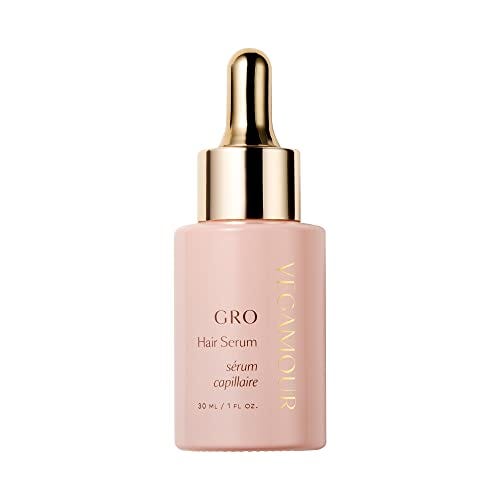Picture this: you’re adding the finishing touches to your hair style for the day when you reach for your favorite edge control product and notice something a little…different. Your edges look a little thinner than you remember. As it turns out, this scenario happens all too often, especially after repeated tight styling.
Generally speaking, hair loss and thinning is extremely common, with more than 50 percent of women experiencing some form at one point in their lives, according to Cleveland Clinic. Additionally, a 2018 study found that traction alopecia (TA) affects one-third of women of African descent due to styling practices—and that’s typically what causes the loss of your edges.
The good news is, there are many ways you can regrow your thinning edges. That includes changing up your styling practices, taking hair growth supplements, or trying out some shampoos for thinning hair (just to name a few). If you’re ready to give your hair the TLC it’s craving, read on for some of the top recommendations from dermatologists.
Meet the experts: Candace Spann, MD, is a board-certified dermatologist and founder of ReTress. Pooja Rambhia, MD, is a board-certified dermatologist in New York and Connecticut. Kristina Collins, MD, is a board-certified dermatologist in Texas.
What causes hair thinning?
There are several factors that contribute thinning edges and hair thinning in general. These includes:
- Traction alopecia: This refers to pulling or tension at the hair follicles from tight hairstyles like braids, ponytails, sew-ins, and buns. “This tension damages the hair follicle, leading to inflammation, follicle weakening, and eventual hair shedding—especially around the edges, which are more fragile,” says Kristina Collins, MD, a board-certified dermatologist in Texas. Over time, the damage can become permanent.
- Postpartum hair loss: This is temporary shedding that occurs about three to four months after giving birth due to hormonal shifts. “With the postpartum shift in hormones, we may experience an increase in shedding,” says Candace Spann, MD, a board-certified dermatologist and founder of ReTress. “During this time, it’s not uncommon for 30 percent of hair to be in the shedding phase instead of the normal 3 percent.” She adds that this kind of shedding usually occurs around the temples.
- Stress: Both chronic and temporary stress can lead to hair loss. Temporary hair thinning and loss can stem from traumatic stress due to things events like divorce, financial loss, the death of a loved one, surgery, severe illness, and rapid weight loss (Ozempic use can contribute to hair loss), says Dr. Spann. Chronic stress can trigger telogen effluvium, which causes the follicles to shift into the resting phase early, adds Dr Collins.
- Polycystic ovary syndrome (PCOS): PCOS is a health problem caused by an imbalance of reproductive hormones. This causes hormone shifts that can affect hair growth that causes thinning around the hairline, says Dr. Collins. She adds that thyroid imbalances can have similar side effects.
- Nutrient deficiencies: A lack of vitamins and minerals that are essential to hair growth, such as iron, vitamin D, and vitamin B (biotin) can lead to breakage, hair loss, and slower progress in regrowth.
- Scalp conditions: Psoriasis or seborrheic dermatitis are inflammatory scalp conditions that can result in flaking and itching, says Dr. Collins. If you do scratch at your scalp too much, you can damage your hair follicles, leading to hair loss or breakage.
- Chemical damage: Chemicals typically used to style hair—think relaxers and dyes—can weaken the hair shaft and lead to breakage and thinning edges, says Dr. Collins. The same applies to using heat tools.
How To Treat Thinning Edges
There are many ways to go about regrowing your edges. Here are the top five tips worth trying, as recommended by dermatologists.
1. Make adjustments to your styling practices
Although there are many styles out there that are considered “protective,” they shouldn’t be left in for more that three weeks, says Dr. Spann. This includes braids, weaves, extensions, and twists because they can put tension on your hair follicles. On top of that, “make sure your braids aren’t too tight and extensions aren’t too heavy as the weight will pull on the delicate follicles around the hairline,” she says. “Sleeping in a silk scarf or satin bonnet every night will also cause localized friction when you are tossing and turning in your sleep, leading to further thinning of the edges.” Instead, try a satin pillowcase to reduce friction.
Ponytails and buns are also common culprits of traction alopecia, explains Pooja Rambhia, MD, a board-certified dermatologist in New York and Connecticut. You should also apply heat protectant before using straighteners or curling irons (on a low to medium setting) to prevent damage. As for your hair brushes, Dr. Rambhia suggests opting for a wide-toothed comb or a brush with gentle bristles to avoid unnecessary tugging.
2. Try over-the-counter products
Before diving head first into in-office treatments, consider reaching for an over-the-counter product instead. One of the most popular picks recommended by Dr. Rambhia: Minoxidil (found in Rogaine). It’s FDA-approved and has a five percent formulation that has been clinically proven to stimulate hair growth.
You can also try caffeine-infused products to improve circulation or Vegamour GRO Hair Serum, which contains Capixyl and peptides to help block DHT (the hormone linked to hair loss). Ingredients like saw palmetto, found in supplements and topicals, can block DHT as well.
3. Prioritize your scalp health
In short: a clean scalp is a healthy scalp. Ideally, you want to keep it moisturized and stick to gentle, sulfate-free shampoos and nourishing conditioners, says Dr. Collins. She adds that this also means taking preventative measures like protecting your scalp from sun damage by wearing hats or products with UV protection.
4. Try an in-office treatment
There are multiple in-office hair-growth treatments that you can speak with your dermatologist about. “One of the most common in-office treatments is platelet-rich plasma (PRP) therapy, which involves drawing a small amount of your blood, processing it to concentrate the platelets, and then injecting it back into the scalp,” says Dr. Rambhia. Doing this treatment monthly stimulates the hair follicles, boosts blood flow, and promotes growth.
Dr. Rambhia also suggests low-level red light laser therapy to stimulate the hair follicles and increase blood flow and cellular activity in the scalp to promote thickness. For a minimally invasive option, microneedling creates small injuries in the scalp that promotes collagen production. However, if your hair loss stems from alopecia areata (a condition that causes the immune system to attack the hair follicles), she notes that steroid injections might be the best choice to reduce inflammation and promote regrowth.
5. Make changes to your diet
It might sound too simple to be true, but eating nutrient-dense foods can support regrowth. Protein, in particular, is essential, since hair is made up of keratin (a kind of protein). That means foods like eggs, lean meats, tofu, and legumes are your best friends. “Biotin-rich foods like eggs and nuts, iron from spinach and lentils, and zinc from oysters and pumpkin seeds are important, too,” says Dr. Rambhia. “Vitamin D, found in fish, and omega-3, found in flaxseeds, promote scalp health and hair regeneration.” A balanced diet combined with ample water intake and less processed foods can lead to stronger hair.
How long does it take for edges to grow back?
Doing one or more of the above suggestions is helpful, but the timeframe for regrowth is different for everyone. “If you’re following the recommended suggestions, it may take anywhere from two to six months to see noticeable improvement,” says Dr. Rambhia. “However, full regrowth can take up a year or longer, especially for those with more significant hair loss.” If you’re not seeing changes, reach out to your doctor to discuss other possible routes.
Sabrina is an editorial assistant for Women’s Health. When she’s not writing, you can find her running, training in mixed martial arts, or reading.






